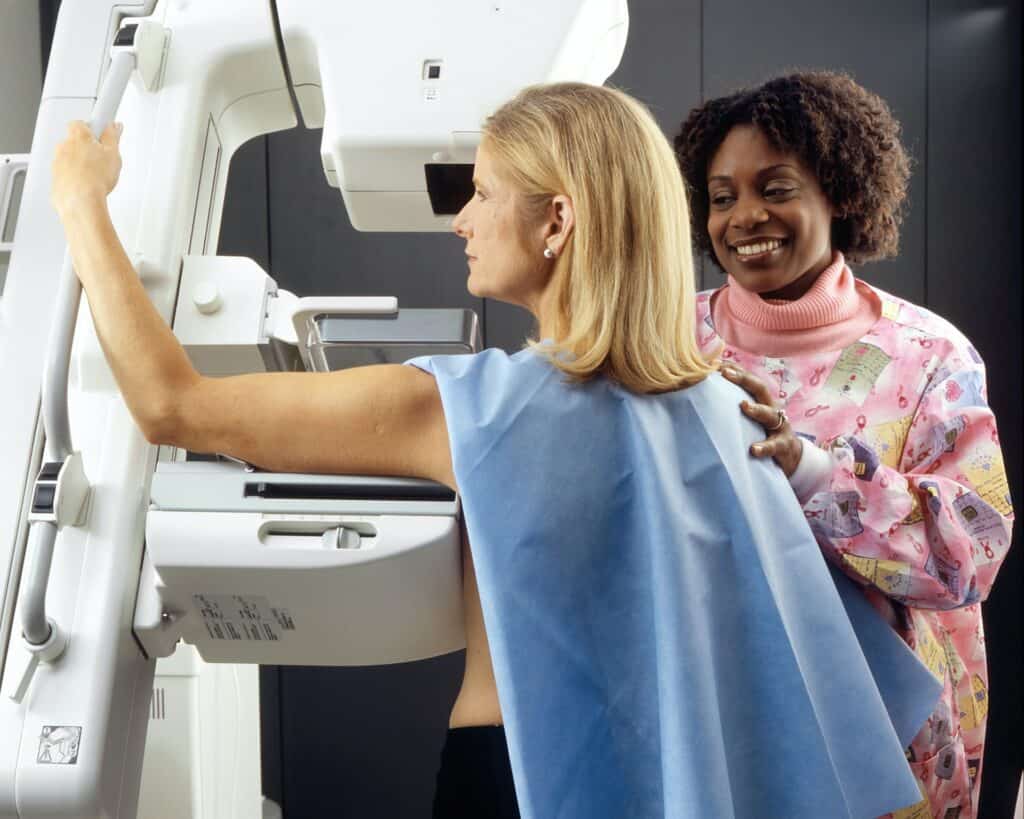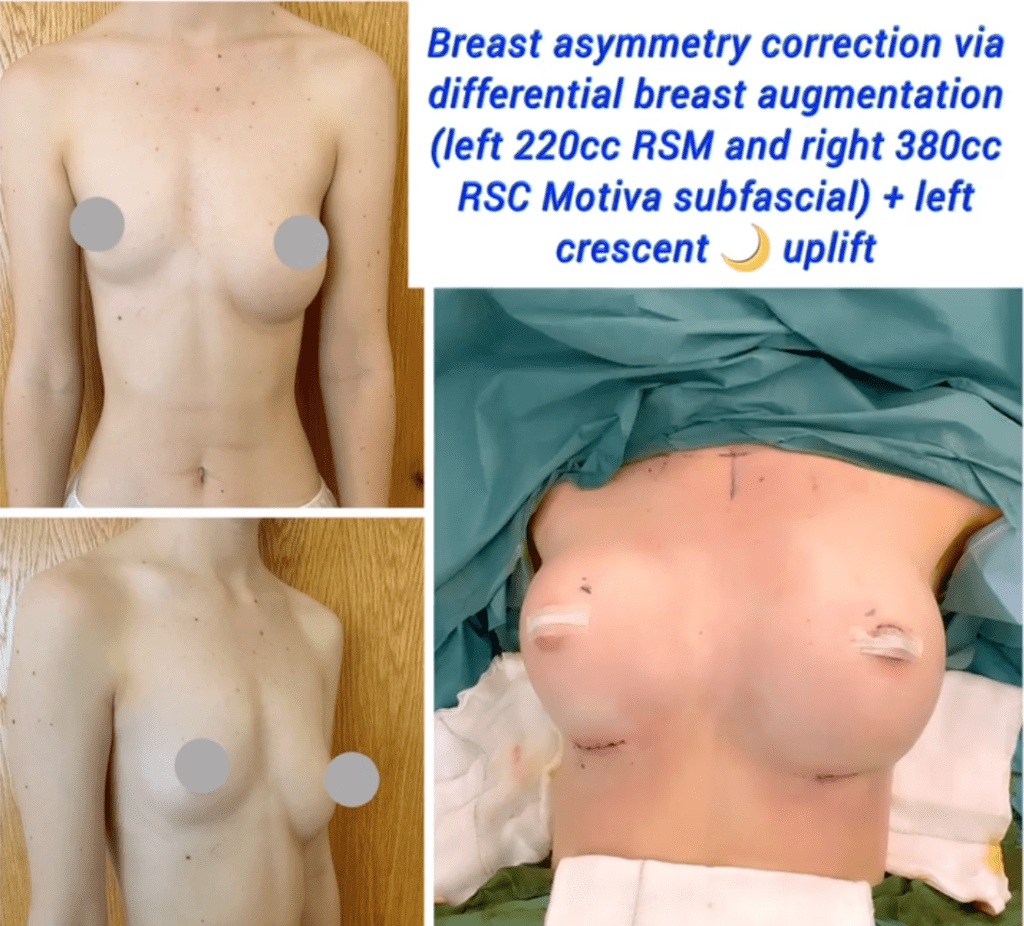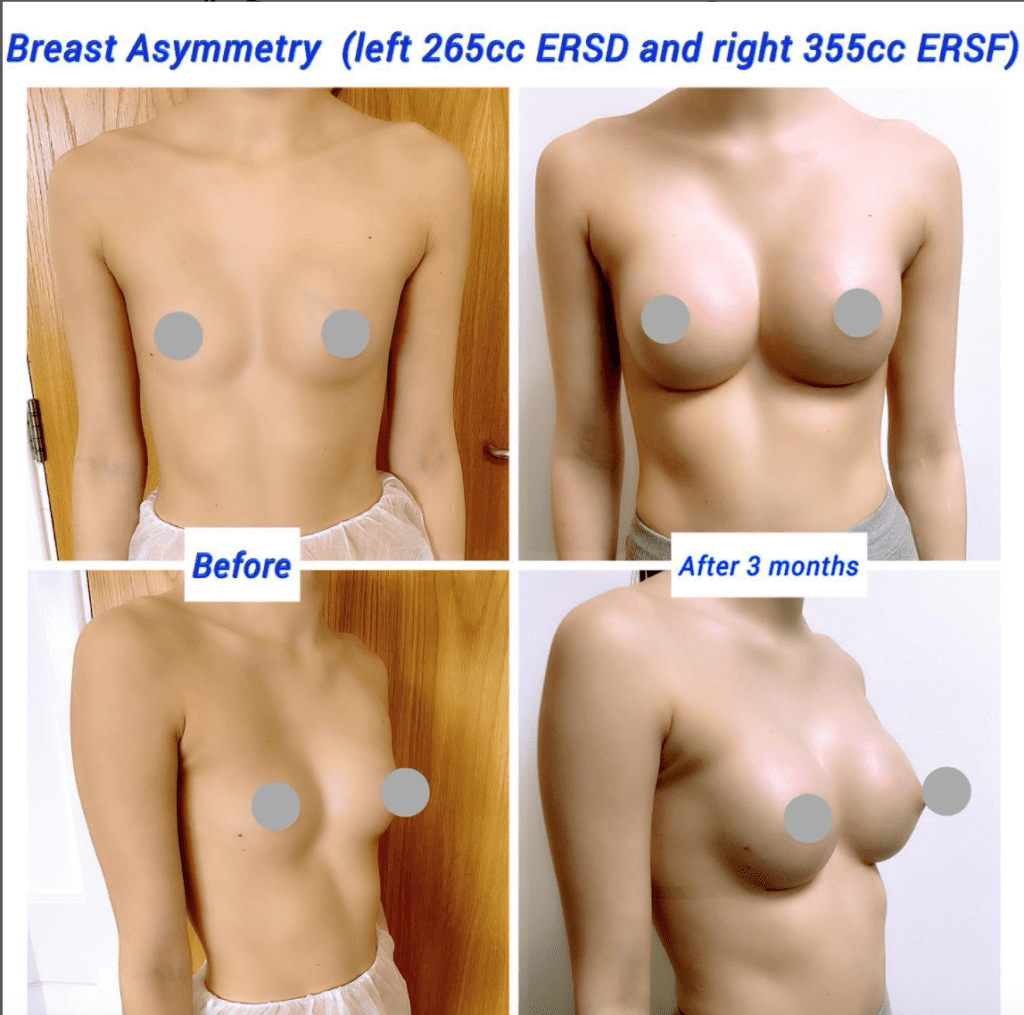It’s common for your breasts to vary in size, shape, or position. Breast asymmetry is likely much more common than you might think. Uneven breasts aren’t usually a cause for concern, but they can impact self-esteem and confidence. Let’s talk about breast asymmetry.
What is Breast Asymmetry?
Women with breast asymmetry have breasts different in size, shape, or position. A lot of women experience mild breast asymmetry without a problem. But when the asymmetry is more significant, it can impact your overall body image.
With breast asymmetry, sometimes you have a difference in volume and size. Other times, the difference is between the nipples and areolas. Some women have a combination of the two. Breast asymmetry is a common condition that affects many women. One option to correct breast asymmetry is through breast symmetrisation, which includes a range of procedures such as breast augmentation and breast reduction.
What Causes Breast Asymmetry?
Uneven breasts can be caused by several factors, including hormones, genetics, puberty, and trauma. It’s not unusual for breasts to look larger during ovulation and then return to normal.
Other causes of breast asymmetry include:
- Pregnancy and breastfeeding
- Hormonal contraceptives
- Juvenile hypertrophy
- Breast cancer
- Hypoplastic breasts (underdeveloped breasts)
Pregnancy and Breastfeeding
During pregnancy and breastfeeding, your body experiences a lot of hormonal changes. These changes affect the shape and size of the breasts causing them to lose fat and tissue and become lumpy.
The breasts will thus appear uneven. These changes usually go away after giving birth or after you’ve stopped breastfeeding.
Hormonal Contraceptives
Hormonal contraceptives contain oestrogen or progestin, which help prevent pregnancy. They include pills, injections, implants, skin patches, intrauterine devices (IUD), and vaginal rings.
Oestrogen and progestin are released into the bloodstream slowly. This can cause significant hormonal changes in the body. The hormones affect body processes like the menstrual cycle, breast size and shape.
Juvenile Hypertrophy
Juvenile hypertrophy is a condition where one or both breasts undergo a huge increase in size during puberty. Usually, breasts and the surrounding structure begin developing during the embryonic stage. If any of the structures don’t develop well, breast asymmetry will occur. The condition causes serious physiological and insecurity issues.
Hypoplastic Breasts
Hypoplastic breasts refer to underdeveloped or tubular breasts. They contain fewer glands and breast tissue that doesn’t support milk production. Hypoplastic breasts appear thin, small, tubular and uneven. They might also be spaced further apart, and in some cases, the areola appears larger.
It is a condition you’re born with and as you grow, the breast tissue doesn’t develop fully. Most women don’t realise they have hypoplastic breasts until they are pregnant or after giving birth. If you have underdeveloped breasts, they don’t change during pregnancy or fill with milk after giving birth.
Breast Asymmetry and Breast Cancer
Breast asymmetry isn’t usually a cause for concern. But, if your breast density suddenly changes or there is a big difference in your asymmetry, it could be a sign of breast cancer. That’s why it’s so important to check your breasts and have regular mammograms if you have breast asymmetry.
Common Breast Asymmetry Questions
When should I worry about breast asymmetry?
Typically, breast asymmetry isn’t a cause for concern. It’s very common to have some differences. However, if you notice a large variation in your breasts or if you start to see a sudden change, you should speak with a doctor. Changes in your breasts may be a sign of cancer, so it’s always a good idea to speak with a medical professional if you have any concerns.
Should I be worried about asymmetry in a mammogram?
It’s common to see breast asymmetry in a mammogram. An asymmetric area could indicate a developing mass. In general, if breast asymmetry shows on a mammogram, you will likely be called back for a diagnostic mammogram. Getting called back for another mammogram is common as it may be that the first image wasn’t clear enough or the radiologist may have seen something that needs further investigation.
Is it normal to have asymmetry breast?
Essentially, breast asymmetry means that the breasts are not completely identical to one another. The reality is that breast asymmetry is normal, and a large number of women have uneven breasts. While it’s quite common to have breast asymmetry, if you experience sudden changes in the look and feel of your breasts, it’s important to speak to a doctor.
How serious is asymmetry on mammogram?
Asymmetries on a mammogram are areas that look different from normal breast tissue. An asymmetry on a mammogram can indicate breast cancer, but it can also be benign or nothing to worry about. The most important thing is to go for your mammogram when called and to keep an eye on changes in your breasts. Having uneven breast size or shape is common and usually not a cause for concern.
How often is breast asymmetry cancer?
When it comes to asymmetry, it’s important to understand that it’s normal to have variations between your breasts. When these changes are new, developing, or sudden, then there’s a chance that it could indicate cancer. As breast asymmetry can be caused by trauma, hormones, pregnancy, and other factors, it’s not necessarily breast cancer.

How do I even out my breast asymmetry?
Breast asymmetry can be easily corrected through cosmetic surgery. The main procedures that focus on correcting breast asymmetry are breast augmentation with implants, breast fat transfer, breast reduction, and a breast lift. The precise approach your plastic surgeon will use will depend on your breast asymmetry. For example, if one breast is larger, then a breast reduction and lift may be more suitable. However, in other cases, breast implants may be a better option. The exact treatment plan will depend on you and your individual case.
Can you fix breast asymmetry without surgery?
When it comes to non-surgical alternatives to fix breast asymmetry, you can use certain clothes and bras to give the appearance of even breasts. But, to actually fix breast asymmetry does require surgery. You can’t change the structure of the breast without surgery. There are no safe and reliable alternatives to surgery that can correct breast asymmetry currently.
How to Fix Underdeveloped Breasts and Breast Asymmetry
Are you looking for ways on how to fix underdeveloped breasts? Uneven breasts are a common occurrence; but, it may get to a point where you find it hard to hide the difference in size. When the volume difference is approaching 30%, it can feel challenging to find clothing and underwear that fits properly and makes you feel good.
If you’re uncomfortable with your breasts and want to have even breasts, a surgical procedure may help you. You can fix breast asymmetry with various treatments, depending on your case.
Breast Enhancement
Breast augmentation is one of the top procedures for women in the UK year on year, according to the latest Plastic Surgery Statistics. For women with extremely uneven breasts, breast enhancement surgery may benefit you. Also referred to as augmentation mammoplasty or a boob job, the surgery involves the use of breast implants to enhance the breasts.

During breast augmentation surgery, a breast implant is inserted behind the breast tissue to increase the size of your breasts. It’s one of the best options if you have hypoplastic breasts. By using an implant, you can create an even pair.
Breast enhancement is also performed by transferring fat from other areas to the breasts. The procedure is known as fat transfer breast augmentation. The plastic surgeon uses liposuction to take fat from areas like the belly, thighs, and back. The fat is then injected into the breasts. The procedure is ideal for those who only need a slight breast size increase.
Breast Lift
Sometimes, you may need a breast lift at the same time as another surgery like breast augmentation or breast reduction. By using a breast lift, you can remove sagging and position the breasts so they can match as much as possible.
Also referred to as mastopexy, the procedure is for you if you don’t like the feel and appearance of your breasts. If your breasts are flat, droopy, or the areola is overly larger, a breast lift can help even them out. These changes occur due to pregnancy, breastfeeding, age, weight changes, genetics and even gravity.
Talk to an expert plastic surgeon today at our Harley Street Clinic, London, if you are considering breast lift surgery.

Breast Reduction
Another option is to have a breast reduction to decrease the size of the larger breast. If you have large breasts that cause back pain as well, this is a good option. The procedure is the most ideal in the case of juvenile hypertrophy. During the surgery, excess skin, fat, and tissue get removed. Men with conditions like gynaecomastia or ‘man boobs’ can also benefit from the procedure.

It’s important to keep an eye on your breasts and monitor any changes. While uneven breasts are not usually a cause for concern, they can really impact your self-esteem and confidence. If you feel like you want to change your uneven breasts with a surgical procedure, speak to an experienced plastic surgeon for expert advice. Like any surgery, breast surgery carries a degree of risk.
If you’re considering breast surgery, book an appointment today with an experienced breast surgeon at our Harley Street facility, the Harley Clinic.
Further Reading:













